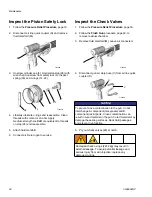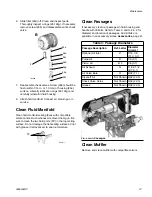
Important Isocyanate (ISO) Information
12
309550ZAP
Material Self-Ignition
Keep Components A and B
Separate
Moisture Sensitivity of
Isocyanates
Exposure to moisture (such as humidity) will cause ISO
to partially cure, forming small, hard, abrasive crystal
that become suspended in the fluid. Eventually a film will
form on the surface and the ISO will begin to gel,
increasing in viscosity.
NOTE:
The amount of film formation and rate of
crystallization varies depending on the blend of ISO, the
humidity, and the temperature.
Foam Resins with 245 fa
Blowing Agents
Some foam blowing agents will froth at temperatures
above 90°F (33°C) when not under pressure, especially
if agitated. To reduce frothing, minimize preheating in a
circulation system.
Changing Materials
Some materials may become self-igniting if applied
too thick. Read material manufacturer’s warnings and
Safety Data Sheets (SDSs).
Cross-contamination can result in cured material in
fluid lines which could cause serious injury or damage
equipment. To prevent cross-contamination:
•
Never
interchange component A and component
B wetted parts.
•
Never use solvent on one side if it has been
contaminated from the other side.
NOTICE
Partially cured ISO will reduce performance and the life
of all wetted parts.
•
Always use a sealed container with a desiccant
dryer in the vent, or a nitrogen atmosphere.
Never
store ISO in an open container.
•
Keep the ISO pump wet cup or reservoir (if
installed) filled with appropriate lubricant. The
lubricant creates a barrier between the ISO and the
atmosphere.
•
Use only moisture-proof hoses compatible with
ISO.
•
Never use reclaimed solvents, which may contain
moisture. Always keep solvent containers closed
when not in use.
•
Always lubricate threaded parts with an appropriate
lubricant when reassembling.
NOTICE
Changing the material types used in your equipment
requires special attention to avoid equipment damage
and downtime.
•
When changing materials, flush the equipment
multiple times to ensure it is thoroughly clean.
•
Always clean the fluid inlet strainers after flushing.
•
Check with your material manufacturer for
chemical compatibility.
•
When changing between epoxies and urethanes or
polyureas, disassemble and clean all fluid
components and change hoses. Epoxies often
have amines on the B (hardener) side. Polyureas
often have amines on the B (resin) side.













































